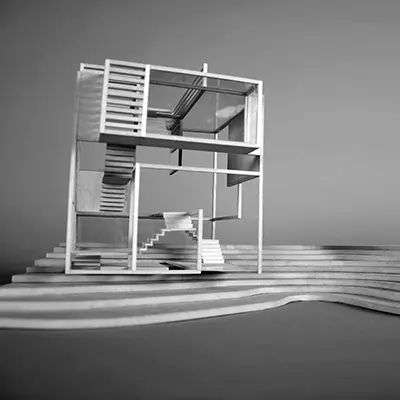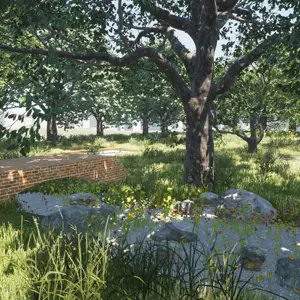Landscape Architecture (BFA)
Landscape Architecture (BFA)
The School of Landscape Architecture BFA program focuses on the development of flexible design processes for landscape and urban design, an understanding of ecological systems, sustainable practices and use of materials, site planning, and advanced drafting and rendering techniques. By graduation, each student will have a portfolio that reflects his or her unique creative vision within this rapidly expanding and evolving profession.
AA MA MFABachelor of Fine Arts (BFA) Degree
Available Online & On Campus
Core Classes





Unit Requirements
| Major Coursework | Units |
|---|---|
| Core | 18 |
| Sophomore Portfolio | 3 |
| Senior Portfolio | 3 |
| Major | 45 |
| Electives | 9 |
| Liberal Arts | 42 |
| Total | 120 |
Degree Requirements
BFA LANDSCAPE ARCHITECTURE DEGREE REQUIREMENTS
- Minimum grade of C- in all core courses, major courses, and the following courses:
LA 115 Natural Systems in the Landscape
LA 117 Survey of Landscape Architecture
LA 255 College Math
LA 271 College Algebra with Geometry
- Minimum 2.0 GPA and the following general education requirements:
3 History of the Built Environment courses
1 Art & Design Communication course
1 Written Communication: Critical Thinking course
1 Fundamental Math course
1 Applied Math course
1 Ecological Systems course
1 History of Landscape Architecture course
1 Historical Awareness course
1 Cultural Ideas & Influences course
1 Employment Communications & Practices course
After above general education requirements are met, take Liberal Arts electives as needed to fulfill the Liberal Arts unit requirement.
Additional Information

Program Learning Outcomes
Undergraduate students will meet the following student performance criteria:
DESIGN PROPOSALS
- Design beautiful and functional outdoor environments of all scales that respond to specific user/client needs and programmatic requirements
- Produce defensible planning and design solutions that reflect knowledge of the cultural, historical, ecological and climatic factors of a given site
RESEARCH AND DESIGN PROCESS
- Conduct a thorough observation and analysis and/or a post-occupancy evaluation of a site in order to determine how people use space
- Work effectively with the natural forms, processes and elements of an indigenous landscape during the entire planning and design process
- Apply the basic principles and elements of design to landscape architecture planning and design proposals
- Explore sufficient concepts and alternative proposals as part of the planning and design process
NATURAL SYSTEMS
- Identify the indigenous components and processes found on any site (soil types, individual plant species, plant communities, wildlife, climatic conditions, and hydrology) and determine the resultant planning and design opportunities and constraints
- Effectively use trees, shrubs, grasses, annuals, perennials and bulbs in their planting designs in order to provide year-round seasonal beauty and function
TECHNICAL SYSTEMS AND MATERIALS
- Design technically accurate and ecologically sensitive grading and drainage plans
- Select materials that will enhance the aesthetic and ecological qualities of a given site as well as provide for the programmatic requirements of the client and/or user group
- Develop construction details that solve structural, functional, aesthetic/environmental issues
- Recognize the design opportunities and limitations of building and construction codes
HISTORICAL PRECEDENT
- Demonstrate sufficient knowledge of historical precedents, including cultural and geographic forces that have shaped major historical gardens, public parks and urban open spaces in their design projects
GRAPHIC/VISUAL COMMUNICATION
- Visually communicate their ideas and proposals (perspectives, axonometrics, plans sections and elevations)
- Successfully use a range of visual media to communicate their ideas and proposals (freehand and computer drawing, drafting, three dimensional models, rendered presentation illustratives)
VERBAL PRESENTATION SKILLS
- Successfully communicate design proposals and key objectives of their projects
- Articulate rationale for design decisions throughout the design process
PROFESSIONAL READINESS
- Produce a professional portfolio demonstrating their skills and design process
- Collaborate effectively with other members of a project team
Academy of Art University Learning Outcomes
Graduates of the Academy of Art University will demonstrate the ability to:
- Produce a body of work suitable for seeking professional opportunities in their chosen field of art and design.
- Solve creative problems within their field of art and design, including research and synthesis of technical, aesthetic, and conceptual knowledge.
- Communicate their ideas professionally and connect with their intended audience using visual, oral, and written presentation skillsrelevant to their field.
- Execute technical, aesthetic, and conceptual decisions based on an understanding of art and design principles.
- Use professional terminology to evaluate their work and work in the field.
- Recognize the influence of major cultural and aesthetic trends, both historical and contemporary, on art and design products.
- Learn the professional skills and behaviors necessary to compete in the global marketplace for art and design
- Engage with a variety of communities beyond the classroom through internship opportunities, study abroad programs, athletics, student interest clubs, and participation in collaborative, civic, and pro bono projects.
*Semester plans are subject to change at any time. Semester breakdowns displayed are suggested and additional options are available to help customize your educational experience. Speak to an admissions or student services representative for more information. Please see our catalog for more details at: https://catalog.academyart.edu